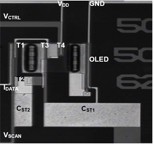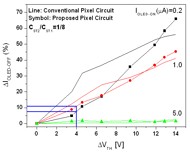
Research Archives index
Electrical Properties and Stability of Current-Scaling a-Si:H TFT Pixel Electrode Circuit for AM-OLEDs
Hojin Lee, Y. C. Lin, and Jerzy Kanicki
 Today the amorphous silicon TFT (a-Si:H TFT) active-matrix organic light-emitting displays (AM-OLEDs) emerge as very promising candidate for the next generation flat panel displays. Since electrical characteristics of a-Si:H TFT are affected by the electrical and thermal stress with the operating time, various pixel electrode circuits have been developed to compensate for these variations with either voltage or current driving methods. In this project, we studied the electrical characteristics of the fabricated pixel electrode circuit based on our previously developed current-driven circuit [1]. The current-driven pixel electrode circuit consists of three switching TFTs (T1, T2, and T4), one driving TFT (T3), and two storage capacitors (CST1, CST2) connected between a scan line and ground with a cascade structure as shown in the figure. The organic light-emitting device (OLED) is represented here by a-Si:H TFT with the gate and drain electrodes connected together. To investigate the current scaling ratio of the fabricated pixel electrode circuit, we changed the IDATA from 0.2 to 10μA and measured the corresponding IOLED_ON and IOLED_OFF flowing through the diode for different ratios of cascaded-capacitors. In ON-state, the IOLED_ON is identical to the data current (IDATA) since the external driver directly controls the OLED current. When the pixel circuit operates in OFF-state, the diode current (IOLED_OFF) is scaled-down by the ratio of cascade capacitor, which enables the current scaling function. These experimental results are in full agreement with the simulated results previously reported [1].
Today the amorphous silicon TFT (a-Si:H TFT) active-matrix organic light-emitting displays (AM-OLEDs) emerge as very promising candidate for the next generation flat panel displays. Since electrical characteristics of a-Si:H TFT are affected by the electrical and thermal stress with the operating time, various pixel electrode circuits have been developed to compensate for these variations with either voltage or current driving methods. In this project, we studied the electrical characteristics of the fabricated pixel electrode circuit based on our previously developed current-driven circuit [1]. The current-driven pixel electrode circuit consists of three switching TFTs (T1, T2, and T4), one driving TFT (T3), and two storage capacitors (CST1, CST2) connected between a scan line and ground with a cascade structure as shown in the figure. The organic light-emitting device (OLED) is represented here by a-Si:H TFT with the gate and drain electrodes connected together. To investigate the current scaling ratio of the fabricated pixel electrode circuit, we changed the IDATA from 0.2 to 10μA and measured the corresponding IOLED_ON and IOLED_OFF flowing through the diode for different ratios of cascaded-capacitors. In ON-state, the IOLED_ON is identical to the data current (IDATA) since the external driver directly controls the OLED current. When the pixel circuit operates in OFF-state, the diode current (IOLED_OFF) is scaled-down by the ratio of cascade capacitor, which enables the current scaling function. These experimental results are in full agreement with the simulated results previously reported [1].
 To evaluate the thermal and electrical stability of our fabricated pixel electrode circuit, we performed the current temperature stress (CTS) experiments for both single TFT and pixel circuit. For the single TFT CTS measurements, we applied the constant gate bias of 30V (VGS=30V) continuously to the TFT while the drain current was set to 2.0 μA at the room temperature (25ºC) for different stressing times (tST) ranging from 0 to 20000 seconds. As the stressing time increases, the threshold voltage shift (?VTH) at 25 ºC increases from 0 to 1.98 V, while ?VTH at 85ºC increases from 0 to 14V. Based on the CTS conditions specified above, we evaluated the stability of the fabricated pixel electrode circuit as a function of the bias stress time. To stress the pixel electrode circuit, the data current (IDATA) of 2μA was supplied to the data electrode during various stress times from 0 to 20000 seconds. For the direct comparison, we performed also CTS of the conventional current-driven circuit [2] under the same experimental conditions. As expected, ?IOLED-OFF of the proposed circuit remains very small (< 1.5%) at high data current level (=5.0 μA) regardless of the device threshold voltage shift. At low current levels (=0.2 μA), the IOLED-OFF shows significant deviation (> 40%) as the a-Si:H TFT threshold voltage shift increases over 10V. During this project, we could show experimentally that the proposed pixel electrode circuit has better electrical and thermal stability than the conventional current-driven circuit under the current temperature stress conditions used in this study. The long-term goal of this project includes the development of new TFT structure to be implemented into the pixel electrode circuits for achieving better electrical and thermal stability for AM-OLEDs. To evaluate the thermal and electrical stability of our fabricated pixel electrode circuit, we performed the current temperature stress (CTS) experiments for both single TFT and pixel circuit. For the single TFT CTS measurements, we applied the constant gate bias of 30V (VGS=30V) continuously to the TFT while the drain current was set to 2.0 μA at the room temperature (25ºC) for different stressing times (tST) ranging from 0 to 20000 seconds. As the stressing time increases, the threshold voltage shift (?VTH) at 25 ºC increases from 0 to 1.98 V, while ?VTH at 85ºC increases from 0 to 14V. Based on the CTS conditions specified above, we evaluated the stability of the fabricated pixel electrode circuit as a function of the bias stress time. To stress the pixel electrode circuit, the data current (IDATA) of 2μA was supplied to the data electrode during various stress times from 0 to 20000 seconds. For the direct comparison, we performed also CTS of the conventional current-driven circuit [2] under the same experimental conditions. As expected, ?IOLED-OFF of the proposed circuit remains very small (< 1.5%) at high data current level (=5.0 μA) regardless of the device threshold voltage shift. At low current levels (=0.2 μA), the IOLED-OFF shows significant deviation (> 40%) as the a-Si:H TFT threshold voltage shift increases over 10V. During this project, we could show experimentally that the proposed pixel electrode circuit has better electrical and thermal stability than the conventional current-driven circuit under the current temperature stress conditions used in this study. The long-term goal of this project includes the development of new TFT structure to be implemented into the pixel electrode circuits for achieving better electrical and thermal stability for AM-OLEDs.
[1] Y. C. Lin, H. D. Shieh, C. C. Su, H. Lee, and J. Kanicki, “A Novel Current-Scaling a-Si:H TFTs Pixel Electrode Circuit for Active Matrix Organic Light-Emitting Displays,” SID 05 Digest, pp. 846-848, 2005.
[2] Y. Hong, J. Y. Nam, and J. Kanicki, “100 dpi 4-a-Si:H TFTs Active-Matrix Organic Polymer Light-Emitting Display,” IEEE J. Selected Topics in Quantum Electron., vol. 10, pp. 16-25, 2004.
H. Lee, Y. C. Lin, Han-Ping Shieh, and J. Kanicki, “Electrical Properties and Stability of Current-Scaling a-Si:H TFT Pixel Electrode Circuit for AM-OLEDs,” ,” IEEE Trans. on Electron Devices, submitted.
top
|

